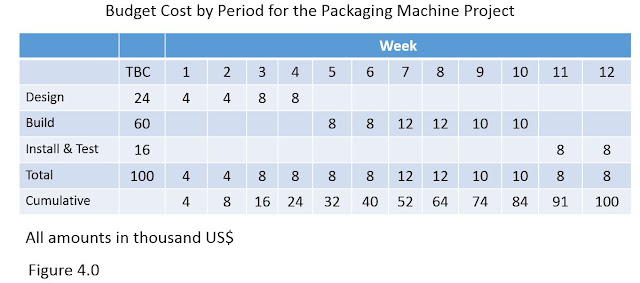1. Actual Cost
To keep track of actual cost on a project, it's necessary to set up a system to collect, on a regular and timely basis, data on funds actually expended. Such a system might include procedures and forms for gathering data. An accounting structure should be established based on the work breakdown structure numbering system so that each item of actual cost can be charged to the appropriate work package. Each work package's actual cost can then be totaled and compared to it's CBC.
Weekly time sheets are often used to collect actual labor costs. Individuals working on the project indicate the numbers of the work package on which they worked and the number of hours they spent of each work package.
These hours are hours are then multiplied by the hourly cost rate for each individual to determine the actual dollar cost. In companies using a matrix organization structure, individuals may be assigned to several project concurrently. In such cases, the individual has to indicate the proper project number as well as the work package number on the time sheet to ensure that the actual labor costs are charger to the appropriate project. When invoices are received for materials or services that were purchased for use on the project, they, too have to be charged to the proper work package number.
In many projects, large dollar amounts are expended for materials or services that are used over a period longer than one cost reporting period. These committed costs need to be treated in a special way so that the system periodically assigns a portion of their total cost to actual cost, rather than waiting until the materials or services are finished to charge to the total actual costs.
Committed costs are also known as commitments or encumbered costs. Costs are committed when an item (material, subcontractor) is ordered, usually by means of a purchase order, even though actual payment may take place at some later time when the material or service has been completed, delivered, and invoiced. When a purchase order are committed and are no longer available to be spent on other project activities. The committed amount must be considered as encumbered, or set aside, because funds will be needed to pay the supplier or subcontractor at some time in the future, when the material or service is delivered and an invoice is received.
For example, if you hire a Contractor to paint your home for $ 5,000, you have committed $ 5,000, even though you may not actually pay the Contractor until the work is finished.
To permit a realistic comparison of actual cost to cumulative budgeted cost, portions of the committed should be assigned to actual cost while the work being performed. In some case, the supplier or subcontractor may require progress payments, rather than waiting until all the work is finished before paid. In such situation, when an invoice is received from the supplier or subcontractor for a partial progress payment, the amount of that invoice should be charged to the actual cost for the proper work package.
3. Comparing Actual Cost to Budgeted Cost
As data are collected on actual cost, including portions of any committed cost, they need to be totaled by work packages so that they can be compared to the cumulative budgeted cost.
Figure 1.0 shows actual cost by time period for each work package through week 8 (Packaging machine project). Also shown is the period by period actual cost for the entire project, as well as the cumulative actual cost (C.A.C).
To permit a realistic comparison of actual cost to cumulative budgeted cost, portions of the committed should be assigned to actual cost while the work being performed. In some case, the supplier or subcontractor may require progress payments, rather than waiting until all the work is finished before paid. In such situation, when an invoice is received from the supplier or subcontractor for a partial progress payment, the amount of that invoice should be charged to the actual cost for the proper work package.
3. Comparing Actual Cost to Budgeted Cost
As data are collected on actual cost, including portions of any committed cost, they need to be totaled by work packages so that they can be compared to the cumulative budgeted cost.
Figure 1.0 shows actual cost by time period for each work package through week 8 (Packaging machine project). Also shown is the period by period actual cost for the entire project, as well as the cumulative actual cost (C.A.C).
Figure 1.0 indicates that at the end of week 8, $ 68,000 has actually been expended on this project. The CBC in Figure 4.0 reveals that only $ 64,000 was budgeted to have spent by the end of week 8. There is a Variance of the $ 4,000 the project is over running its Budget.



No comments:
Post a Comment